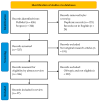Exercise Mimetics in Aging: Suggestions from a Systematic Review
- PMID: 40289996
- PMCID: PMC11944853
- DOI: 10.3390/nu17060969
Exercise Mimetics in Aging: Suggestions from a Systematic Review
Abstract
Background/Objectives: Growth in the aging world population is accompanied by an increase in comorbidities, profoundly impacting the quality of life of older people. This development has motivated a large effort to investigate the mechanisms underlying aging and the search for countermeasures. The most investigated strategies envisage the control of diet and physical exercise, which exploit both common and distinct mechanisms to promote health. Since the application of nutritional and exercise protocols to aged persons introduces several issues due to their disabled state, some strategies have been developed. The nutritional approach exploits a wide range of compounds, including calorie restriction mimetics, supplements, antioxidants, and others. In the context of exercise, in recent years, molecules able to provide similar effects to exercise, the so-called exercise mimetics, have been developed. Methods: To have a better perspective on exercise mimetics and their connection with nutrition, we performed a systematic search of the PubMed and Scopus databases using the term "exercise mimetics". Results: In total, 97 research articles were selected and discussed. The present review provides evidence of the presence of multiple exercise-mimetic compounds and physical strategies that can target metabolic pathways, oxidative stress defense mechanisms, or myokine modulation. Conclusions: Interestingly, this review highlights that an important number of exercise mimetics are represented by products of natural origin and supplements assimilable with diet. This evidence provides a further link between exercise and nutrition and confers a central role on nutrition in the context of exercise mimetics.
Keywords: aging; exercise; exercise mimetics; health span; lifespan; metabolism; myokines; natural compounds; nutrient sensing pathway.
Conflict of interest statement
The authors declare no conflicts of interest.
Figures


Similar articles
-
[Volume and health outcomes: evidence from systematic reviews and from evaluation of Italian hospital data].Epidemiol Prev. 2013 Mar-Jun;37(2-3 Suppl 2):1-100. Epidemiol Prev. 2013. PMID: 23851286 Italian.
-
Systemic pharmacological treatments for chronic plaque psoriasis: a network meta-analysis.Cochrane Database Syst Rev. 2021 Apr 19;4(4):CD011535. doi: 10.1002/14651858.CD011535.pub4. Cochrane Database Syst Rev. 2021. Update in: Cochrane Database Syst Rev. 2022 May 23;5:CD011535. doi: 10.1002/14651858.CD011535.pub5. PMID: 33871055 Free PMC article. Updated.
-
The Black Book of Psychotropic Dosing and Monitoring.Psychopharmacol Bull. 2024 Jul 8;54(3):8-59. Psychopharmacol Bull. 2024. PMID: 38993656 Free PMC article. Review.
-
Systemic pharmacological treatments for chronic plaque psoriasis: a network meta-analysis.Cochrane Database Syst Rev. 2020 Jan 9;1(1):CD011535. doi: 10.1002/14651858.CD011535.pub3. Cochrane Database Syst Rev. 2020. Update in: Cochrane Database Syst Rev. 2021 Apr 19;4:CD011535. doi: 10.1002/14651858.CD011535.pub4. PMID: 31917873 Free PMC article. Updated.
-
Factors that influence participation in physical activity for people with bipolar disorder: a synthesis of qualitative evidence.Cochrane Database Syst Rev. 2024 Jun 4;6(6):CD013557. doi: 10.1002/14651858.CD013557.pub2. Cochrane Database Syst Rev. 2024. PMID: 38837220 Free PMC article. Review.
References
-
- Ageing and Health. [(accessed on 24 February 2025)]. Available online: https://www.who.int/news-room/fact-sheets/detail/ageing-and-health.
Publication types
MeSH terms
Substances
LinkOut - more resources
Full Text Sources
Medical

